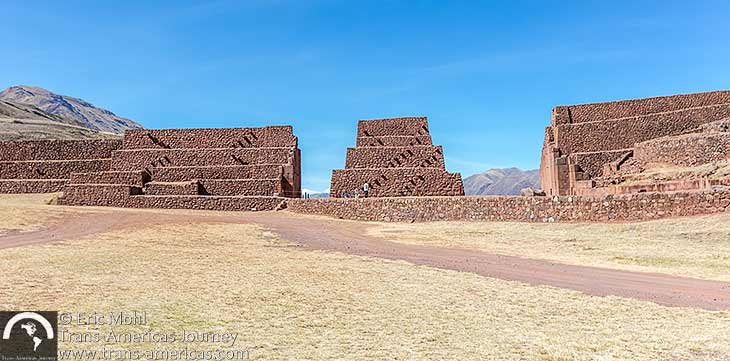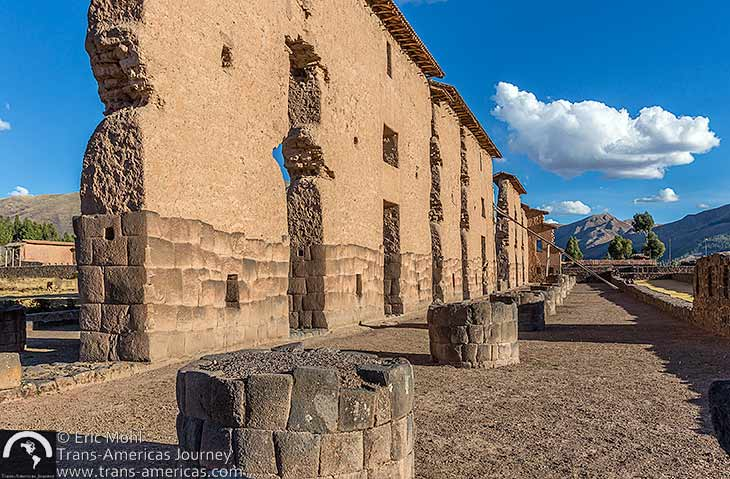Archaeological Exploration – Around Cuzco, Peru
The area around Cuzco, Peru is full of Incan and pre-Incan archaeological sites of all shapes and sizes including some that you can visit as a day trip from Cuzco (spelled Cusco locally). Other Incan sites, including Tipón, Pikillacta, Rumicola, Raqch’i, Tirawasi, and Piedra Sayhuite, are further away but worth the journey to see beautifully crafted (and still working) fountains, a massive carved boulder, and walls so high that even the Incans couldn’t build them entirely out of stone.
The first four archaeological sites in this post are located east of Cuzco (in order of closeness to the city itself). The last two sites are located west of the city.

Tipón archaeological site
Pull off the Cusco-Puno highway about 15 miles (22 km) from Cuzco, turn onto a narrow, steep, and winding (though now fully-paved) road and you’ll soon reach the 595 acre (240 hectare) Tipón archaeological site. Built in the 15th century by the Incas, the site has terraces which were used for agriculture.

However, the most unusual features of the Tipón archaeological site are its natural springs and man-made waterways. Excavated areas feature precise, stone-lined aqueducts and fountains which are beautiful as well as functional (water still runs through these channels).


Pikillacta archaeological site
About 21 miles (33 km) east of Cuzco you’ll find the Pikillacta archaeological site (also spelled Piqillacta, Piquillacta, or Piquillaqta) which was built by the pre-Incan Wari people and occupied from about 550 AD to about 1100 AD. The site was extensively excavated between the late ’70s and the late ’90s and reveling elements like pottery and stored food were found.

Walls like these are a defining feature of the Pikillacta archaeological site.
Experts believe the main use for the site, which is rarely visited (we had the place to ourselves, was ceremonial. The most striking thing for visitors are the large stone walls that enclose the 1 square mile (~2 square km) site. Interior walls further subdivide the site into distinct blocks containing more than 700 structures, mostly still in ruins. However, a few important buildings in the ceremonial center of the site have been fully excavated and restored. Some contain original plaster on the walls and floors.

Rumicolca archaeological site
The Wari people built it before the Incas took over, but what was it used for? Some say it was a gate that marked a boundary of the Wari’s domain. Others say it was part of an aqueduct. Either way, we can tell you that the stark Rumicola structure, located alongside the main highway into the city from the East about 10 minutes from Cuzco, is very dramatic. You can’t miss it.

The Wari people were pre-Incan but they had some stone skills of their own which were added to and improved by the Incas, as you can see at the Rumicola archaeological site.
Raqch’i archaeological site
Don’t let the crush of vendors selling the usual tourist crap deter you from the Raqch’i archaeological site, located about 75 miles (121 km) from Cuzco near the town of Sicuani (20 soles per person or about US$6, guides available in Spanish only, allow 40 minutes to tour the site).

Part of what’s left of an imposing temple at the Raqch’i archaeological site in Peru.
Navigate through the vendors and you’ll find a charming church (worth a quick look) next to the site itself which has a park-like feeling with grassy areas and a large pond that ducks and Andean gulls seem to love.

The centerpiece of the Raqch’i site, which experts believe was used for defense and for rituals, is the enormous Temple of Wiracocha and its 20 stone pillars (one rebuilt) which held up what’s believed to be the largest known Incan roof. The structure was also incredibly tall, requiring soaring walls which were too tall to build entirely in stone, so the upper portions were made from adobe bricks on a base of cut stone.

There are more than 150 round stone structures like this one at the Raqch’i site.
There are also more than 150 round stone structures with thatch roofs (two have been rebuilt) that were colcas or Incan storehouses where grain and other goods were kept. These storehouses were made from volcanic rock found at the site. At Raqch’i, only the temple was constructed using cut stone. Unfortunately, there were no signs or other types of explanations at the Raqch’i site when we were there and all onsite guides only spoke Spanish.

Only the temple at Raqch’i was constructed using cut stones. Other structures were made from rough volcanic rock found on site.
There are two other Incan sites next to Raqch’i, but they were closed by the time we were done exploring this large and unusual site.
The following archaeological sites are located west of Cuzco.
Tarawasi archaeological site
At the Tarawasi (sometimes spelled Tarahuasi) archaeological site, 46 miles (76 km) west of Cuzco, you can see excellent examples of Incan stonework (10 soles per person or about US$3, allow 15 minutes to see the site).

Look for the (unintentional?) flower and heart patterns in the configuration of the stones which form the base around a raised platform which the caretaker of the site told us was used for rituals.


Piedra Sayhuite archaeological site
The Piedra Sayhuite (sometimes spelled Suihuite or Saywite) is on the site of what experts believe was an Incan temple. Today, all that remains to be seen at this archaeological site, located 92 miles (148 km) west of Cuzco, is a massive boulder with hundreds of images carved into it (10 soles or about US$3 per person, allow 10 minutes to admire the boulder).

The intricately carved boulder at the Piedra Sayhuite archaeological site.
The deep carvings depict animals (frogs, felines, etc) as well as terraces and waterways. In fact, water may have flowed through the carvings and the boulder itself may have been the centerpiece of the temple. Feeling lazy? Go to Avenida Camino Real in the San Isidro neighborhood of Lima, Peru and you’ll find a life-size replica of the Piedra Sayhuite.
